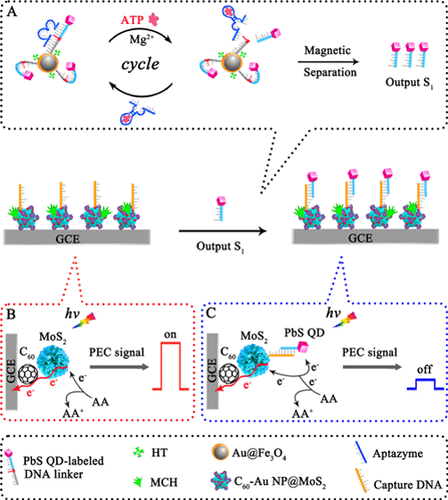当前位置:
X-MOL 学术
›
ACS Appl. Mater. Interfaces
›
论文详情
Our official English website, www.x-mol.net, welcomes your
feedback! (Note: you will need to create a separate account there.)
Using p-type PbS Quantum Dots to Quench Photocurrent of Fullerene–Au NP@MoS2 Composite Structure for Ultrasensitive Photoelectrochemical Detection of ATP
ACS Applied Materials & Interfaces ( IF 8.3 ) Pub Date : 2017-11-17 00:00:00 , DOI: 10.1021/acsami.7b13894 Meng-Jie Li 1 , Ying-Ning Zheng 1 , Wen-Bin Liang 1 , Ruo Yuan 1 , Ya-Qin Chai 1
ACS Applied Materials & Interfaces ( IF 8.3 ) Pub Date : 2017-11-17 00:00:00 , DOI: 10.1021/acsami.7b13894 Meng-Jie Li 1 , Ying-Ning Zheng 1 , Wen-Bin Liang 1 , Ruo Yuan 1 , Ya-Qin Chai 1
Affiliation

|
Ultrasensitive and rapid quantification of the universal energy currency adenosine triphosphate (ATP) is an extremely critical mission in clinical applications. In this work, a “signal-off” photoelectrochemical (PEC) biosensor was designed for ultrasensitive ATP detection based on a fullerene (C60)-decorated Au nanoparticle@MoS2 (C60–Au NP@MoS2) composite material as a signal indicator and a p-type PbS quantum dot (QD) as an efficient signal quencher. Modification of wide band gap C60 with narrow band gap MoS2 to form an ideal PEC signal indicator was proposed, which could significantly improve photocurrent conversion efficiency, leading to a desirable PEC signal. In the presence of p-type PbS QDs, the PEC signal of n-type C60–Au NP@MoS2 was effectively quenched because p-type PbS QDs could compete with C60–Au NP@MoS2 to consume light energy and electron donor. Besides, the conversion of a limited amount of target ATP into an amplified output PbS QD-labeled short DNA sequence (output S1) was achieved via target-mediated aptazyme cycling amplification strategy, facilitating ultrasensitive ATP detection. The proposed signal-off PEC strategy exhibited a wide linear range from 1.00 × 10–2 pM to 100 nM with a low detection limit of 3.30 fM. Importantly, this proposed strategy provides a promising platform to detect ATP at ultralow levels and has potential applications, including diagnosis of ATP-related diseases, monitoring of diseases progression and evaluation of prognosis.
中文翻译:

使用p型PbS量子点猝灭富勒烯–Au NP @ MoS 2复合结构的光电流,用于ATP的超灵敏光电化学检测
通用能量货币三磷酸腺苷(ATP)的超灵敏和快速定量是临床应用中极为关键的任务。在这项工作中,基于富勒烯(C 60)修饰的Au纳米粒子@ MoS 2(C 60 –Au NP @ MoS 2)复合材料,设计了一种“信号关闭”光电化学(PEC)生物传感器用于超灵敏ATP检测。信号指示器和p型PbS量子点(QD)作为有效的信号猝灭剂。用窄带隙MoS 2修饰宽带隙C 60提出了一种理想的PEC信号指示器,可以显着提高光电流转换效率,从而产生理想的PEC信号。在存在p型PbS QD的情况下,n型C 60 –Au NP @ MoS 2的PEC信号被有效猝灭,因为p型PbS QD可以与C 60 –Au NP @ MoS 2竞争以消耗光能和电子给体。此外,通过靶标介导的aptazyme循环扩增策略实现了将有限量的靶标ATP转化为扩增的输出PbS QD标记的短DNA序列(输出S 1),从而促进了超灵敏的ATP检测。拟议的信号关闭PEC策略在1.00×10 –2的线性范围内表现出优势pM为100 nM,检测限为3.30 fM。重要的是,该提议的策略为检测超低水平的ATP提供了一个有前途的平台,并具有潜在的应用,包括与ATP相关的疾病的诊断,疾病进展的监测和预后的评估。
更新日期:2017-11-19
中文翻译:

使用p型PbS量子点猝灭富勒烯–Au NP @ MoS 2复合结构的光电流,用于ATP的超灵敏光电化学检测
通用能量货币三磷酸腺苷(ATP)的超灵敏和快速定量是临床应用中极为关键的任务。在这项工作中,基于富勒烯(C 60)修饰的Au纳米粒子@ MoS 2(C 60 –Au NP @ MoS 2)复合材料,设计了一种“信号关闭”光电化学(PEC)生物传感器用于超灵敏ATP检测。信号指示器和p型PbS量子点(QD)作为有效的信号猝灭剂。用窄带隙MoS 2修饰宽带隙C 60提出了一种理想的PEC信号指示器,可以显着提高光电流转换效率,从而产生理想的PEC信号。在存在p型PbS QD的情况下,n型C 60 –Au NP @ MoS 2的PEC信号被有效猝灭,因为p型PbS QD可以与C 60 –Au NP @ MoS 2竞争以消耗光能和电子给体。此外,通过靶标介导的aptazyme循环扩增策略实现了将有限量的靶标ATP转化为扩增的输出PbS QD标记的短DNA序列(输出S 1),从而促进了超灵敏的ATP检测。拟议的信号关闭PEC策略在1.00×10 –2的线性范围内表现出优势pM为100 nM,检测限为3.30 fM。重要的是,该提议的策略为检测超低水平的ATP提供了一个有前途的平台,并具有潜在的应用,包括与ATP相关的疾病的诊断,疾病进展的监测和预后的评估。











































 京公网安备 11010802027423号
京公网安备 11010802027423号